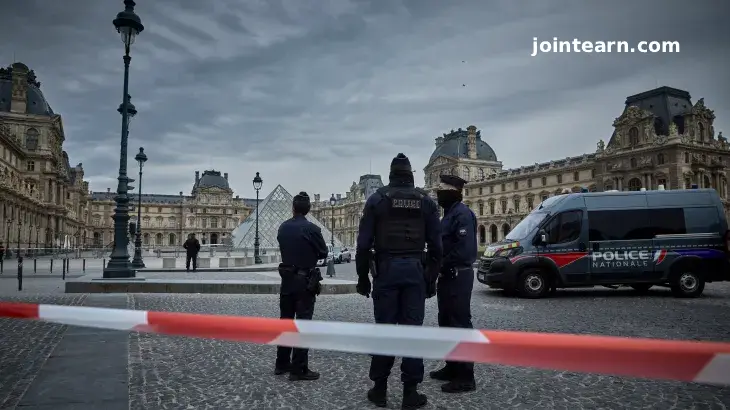
Paris, France — October 30, 2025
French authorities have arrested five additional suspects in connection with the Louvre Museum jewellery heist, bringing the total number of arrests to seven, prosecutors confirmed. Despite the growing list of suspects, none of the stolen Napoleonic-era jewels—valued at nearly €88 million ($102 million)—have yet been recovered.
Expanding Investigation: Seven in Custody After Four-Minute Heist
According to Paris Public Prosecutor Laure Beccuau, the new arrests were made late on Wednesday evening in and around the Paris metropolitan area, including the Seine-Saint-Denis region.
“We had him in our sights,” Beccuau told French radio station RTL, referring to one suspect identified through DNA evidence found at the crime scene. “He was one of the key objectives of the investigators.”
The five suspects were taken into custody at separate police stations across the Paris area. While their identities have not been disclosed, authorities believe the arrests could help trace the missing crown jewels stolen in the audacious break-in.
The announcement follows the earlier detention of two suspects who, according to prosecutors, “partially admitted” to charges of organised theft and criminal conspiracy—serious crimes carrying prison terms of up to 15 years and 10 years, respectively.
How the Louvre Jewellery Heist Unfolded
On the morning of October 19, as thousands of visitors strolled through the historic halls of the Louvre Museum, a group of well-coordinated intruders executed one of the most daring museum thefts in decades.
The thieves reportedly broke into the Apollo Gallery—home to France’s royal crown jewels—through an upper-level window, disabling motion sensors and bypassing several alarm systems. Within four minutes, they made off with eight priceless pieces of jewellery, vanishing before museum security could respond.
Among the stolen treasures were:
- A pearl-adorned tiara once worn by Empress Eugénie, wife of Napoleon III
- Diamond necklaces and earrings from the Napoleonic era
- A 19th-century brooch belonging to Empress Joséphine, wife of Napoleon Bonaparte
Authorities have since confirmed that none of these artifacts—considered irreplaceable pieces of French history—have been recovered.
Early Arrests and Partial Confessions
The investigation gained momentum over the past week when police apprehended two men, aged 34 and 39, in Aubervilliers, a suburb north of Paris. Both were linked to the heist through surveillance footage and forensic evidence.
Beccuau told reporters that the pair had “partially admitted” their involvement, though they stopped short of revealing the current whereabouts of the jewels or other accomplices.
The arrests sparked a wider police operation, leading investigators to trace communication networks and financial transactions across France and neighboring European countries.
Louvre Museum Faces Security Scrutiny
The Louvre Museum, the world’s most visited cultural landmark, has faced intense criticism since the heist. Museum Director Élodie Martin-Duval testified before the French Senate last week, acknowledging lapses in the museum’s security systems.
“Our operations did not detect the arrival of the thieves soon enough,” Martin-Duval said, adding that she had offered her resignation to the Minister of Culture—who ultimately declined to accept it.
Experts have described the heist as “a terrible failure in museum security,” citing the thieves’ ability to enter through a high-level access point and escape undetected within minutes. The Louvre has since announced plans to reinforce security protocols, install new surveillance technology, and increase night-time patrols.
The Hunt for Priceless Napoleonic Treasures
The stolen collection, estimated at €88 million, includes jewels originally crafted for French imperial royalty. These historical pieces are considered cultural heritage items, meaning they cannot legally be sold or exported.
Interpol and art crime divisions across Europe are now working alongside French authorities to track potential black-market channels where the jewels might surface. Investigators believe the items could be disassembled, recut, or smuggled out of France through underground art networks.
“It is likely that whoever orchestrated this theft had inside knowledge of the museum’s layout and security systems,” said one investigator familiar with the case. “Recovering these pieces will take time and international cooperation.”
A Crime That Shocked the Art World
The Louvre heist has drawn comparisons to some of the most infamous art and jewellery thefts in history, such as the Gardner Museum robbery in Boston and the Harry Winston diamond theft in Paris.
Experts say the latest incident highlights the growing sophistication of criminal groups targeting high-value cultural assets.
French media outlets have called the event “a blow to the nation’s cultural pride,” emphasizing the Louvre’s symbolic importance as a guardian of world heritage.
What Happens Next?
Prosecutor Beccuau confirmed that the investigation remains ongoing, with the new suspects expected to appear before an investigating magistrate in the coming days.
Authorities are confident that the expanding arrests could soon lead them closer to recovering the stolen jewels and uncovering the mastermind behind the operation.
For now, the Apollo Gallery remains partially closed as forensic teams continue to examine the scene. Visitors to the Louvre have expressed sadness and disbelief that such a high-security museum could fall victim to a heist executed in just minutes.


Leave a Reply